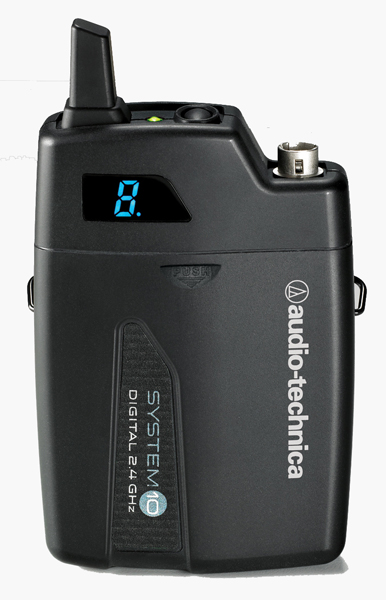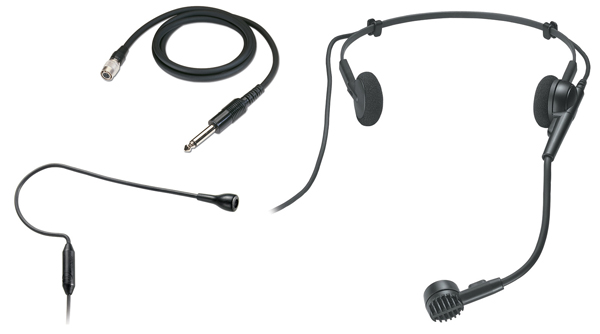|
Mar. 15, 2013, by Gary Parks
Audio-Technica’s first entry into digital wireless was SpectraPulse, a specialized system for secure conferencing applications. Now with the new System 10, A-T has brought digital wireless into a simple format at popular price points.
System 10 is not a professional touring wireless microphone system, like the company’s 4000 and 5000 Series, yet it implements some impressive technology in an easy-to-use package. The system sounds good and contains a variety of integral features that solve common wireless performance and coordination problems.
Operating in the 2.4 GHz band, System 10 allows up to eight units to work together, depending on interference conditions from wi-fi and other devices in that band. The system is designed to automatically search out clear frequencies, work fluidly with multiple channels of wireless in the same location, and maintain bi-directional communication between paired transmitters and receivers.
Multiple Diversity Methods
The transmission scheme uses three different diversity methods, which all happen “behind the scenes” – a mix of frequency, time, and space diversity.
Beginning with frequency diversity, the handheld and beltpack transmit on two different frequencies simultaneously, and the receiver selects the one with the highest signal-to-noise ratio to convert to audio. When the receiver is turned on, it selects these frequencies after surveying the RF environment, and communicates them to the associated transmitter as soon as it is on.

System 10 half-rack-sized ATW-R100 receiver, made for stand-alone use. (click to enlarge)
The receiver also selects a couple additional clear frequencies for backup at turn-on. If one of the active frequencies is encountering significant interference during use, the receiver automatically selects and relays a clear frequency to the transmitter, replacing the one experiencing interference.
In addition, the digital audio “data packets” are transmitted in slightly different time slots. Thus the identical data is received twice, and the packet without errors is decoded within the receiver, countering potential multipath problems. System 10 also uses space diversity with a twist, adding a pair of spaced antennas in the transmitter each sending a signal, along with the standard dual antennas on the receiver.
System Pairing
A-T uses a process of “pairing” a transmitter with a receiver, so that they communicate bi-directionally and function as a unit. After selecting a channel ID number 1 through 8, the user presses the pairing button on the receiver and subsequently activates the button in the transmitter’s battery compartment at close range to sync them together. The transmitter’s display now shows the same ID number, and the system is ready to use.

ATW-T1002 handheld transmitter with LED on the body clearly showing channel. (click to enlarge)
The system number shown in the display is solely for identification of the paired systems, and has no relationship to the frequencies the unit is transmitting on. In fact, all of the systems being used together could have the same displayed ID number and would still function as a coordinated installation. At various times when the same unit is used, it may well be using a different set of frequencies based on what is currently clear and available.
The pairing method is quick to learn, and can be used to switch between a handheld and bodypack using the same receiver, or to add a new transmitter to the system. I attempted to pair a transmitter with two receivers to see if redundancy is possible, but only a one-to-one relationship is permitted.
Audio Quality
System 10 is fully digital, offering 24-bit/48-kHz audio with no analog companding circuitry or the potential interference effects possible with analog transmission that result from interference or low signal strength.
The handheld mic sounds good, featuring balanced lows without excessive proximity effect, as well as even mids and sufficient highs for intelligibility – though not as crisp and articulate as a higher end condenser would yield. The polar pattern appears to fall somewhere between supercardioid and cardioid, with the deepest nulls around 75 to 80 degrees off-axis.
Attenuation at the rear of the mic is moderate, with the lows and mids still being picked up. Handling noise is acceptable.
The audio quality using the bodypack and the supplied PRO 92cW-TH omni headset was clean and uncolored with spoken word – the natural response I’ve often found in the new digital systems.
With an instrument cable, acoustic guitar reproduced the full range of the instrument with any resultant coloration coming from the pickup and amp combination, and compared favorably with a standard guitar cable.
System Components
The half-rack-sized ATW-R100 receiver was surprisingly light. Its construction is molded ABS, and the unit seems durable, with tight joints and good resistance to flexing.
The receiver is made for stand-alone use rather than rack-mounting. Permanently attached front-mounted antennas and stacking feet that fit into recesses on the top plate allow several units to share the same real estate.
The simple front panel provides a 1-character blue LED display, along with two buttons to select and pair channel ID numbers and two LEDs to indicate connection with the transmitter and audio overload.

ATW-T1001 “UniPak” bodypack with a versatile Hirose-type connector. (click to enlarge)
The rear panel has balanced XLR and unbalanced quarter-inch connectors, with a rotary level control. The unit is powered with a compact external supply that takes up only one space within the power strip.
The ATW-T1002 handheld transmitter is durably built and somewhat hefty. It is attractively shaped and feels good in the hand, with a smooth matte finish that sometimes didn’t offer enough friction to keep the mic from slipping toward the head when I loosened my grip.
The only external control offered on this transmitter is an on/off/mute button on the butt end of the handle, adorned with the A-T logo. A touch and brief hold turns the transmitter on or off, and a quick touch will mute or unmute it.
The ATW-T1001 “UniPak” bodypack has a substantial feel while being fairly light in weight and moderately sized. The only external control is an on/off/mute button on the top surface next to the antenna. A Hirose-type connector is used, and A-T offers a variety of headset and lavalier mics in this format; third-party microphones are also available.

Additional microphone options with the beltpack, along with instrument cable. (click to enlarge)
The battery cover encompasses much of the front surface, and becomes a functional design element. When I first attempted to open it I had a bit of difficulty, but after pressing the indentation molded into the top of the cover, it opened with a significant click and closed easily after I inserted batteries. I ran through this procedure several times, and it seems to be durable and not inclined to break or open unexpectedly.
Both transmitters have a level control to adjust the audio signal prior to transmission, and a small screwdriver is provided in the battery compartment for this purpose. The 10-milliwatt RF output power yields a typical operating range of 100 feet (30 meters). Battery life is greater than seven hours.
Conclusions & Pricing
With the System 10, A-T has achieved a plug-and-play digital wireless system that is simple for an inexperienced operator to use successfully when a handful of channels are required. Virtually all of the technical aspects of coordination are automated, and the multiple diversity methods keep the system performing well even in interference conditions. This is perhaps the easiest of the new digital systems to run.
A variety of system options and accessory microphones are available, with U.S. list prices ranging from $490 to $665.
| 



